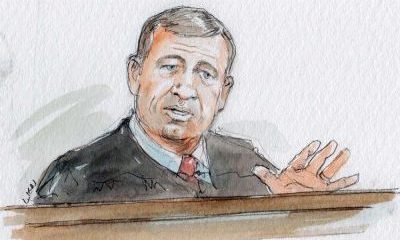SCOTUS NEWS
After a year of turmoil for the court, Roberts lauds judicial-security measure

on Dec 31, 2022 at 6:00 pm

2022 was a turbulent year for the Supreme Court.
In May, a draft opinion by Justice Samuel Alito was leaked to the press, revealing that a majority of the court was poised to overturn the constitutional right to an abortion. Less than two months later, a divided court made that decision official, in Dobbs v. Jackson Women’s Health Organization. In public appearances over the summer, the justices lobbed potshots at each other, while protesters rallied outside the homes of the conservative justices. Justice Brett Kavanaugh was the target of a thwarted assassination attempt, and Justice Clarence Thomas’ wife testified before the committee investigating the Jan. 6, 2021, attacks on the Capitol. In October, the court began its 2022-23 term with its lowest public approval ratings in modern history.
The annual report of Chief Justice John Roberts, released on Saturday evening, addressed the court’s difficult year only obliquely. He offered a historical parable to highlight the importance of security for federal judges, and he praised Congress for passing a law to increase protection for judges and their families.
Roberts, however, did not address the Dobbs leak or the status of the court’s leak investigation, which Roberts announced in May. He also did not provide an update on efforts by the judicial branch to respond to reports of ethics violations and allegations of sexual harassment, which Roberts had indicated in last year’s report would “receive focused attention in the coming months.”
This year, Roberts recounted the story of the Little Rock Nine, the nine African American children who were the first to attend the previously all-white Central High School after the court’s landmark 1954 decision in Brown v. Board of Education, striking down racial segregation in public schools. Thurgood Marshall, the attorney who argued Brown and who would become the court’s first African American justice 10 years later, played a key role in litigation to integrate Arkansas schools after Brown. Roberts acknowledged Marshall’s efforts, but the hero of Roberts’ story was U.S. District Judge Ronald Davies, a North Dakotan who found himself presiding over post-Brown desegregation litigation while substituting for an Arkansas judge who had fallen ill.
Davies, Roberts noted, paid a heavy personal price for his work in the desegregation case. He missed his son’s wedding – a sacrifice, Roberts suggested, that is mirrored by the federal judges “who quietly, diligently, and faithfully discharge their duties every day of the year.” Davies, Roberts continued, was also “physically threatened for following the law.” But, Roberts emphasized, a “judicial system cannot live in fear.”
Roberts praised U.S. District Judge Esther Salas of New Jersey, whose son was killed in 2020 in an attack on her home, for her advocacy on behalf of judicial security. Those efforts, Roberts noted, came to fruition this month, when Congress passed a judicial-security law named after Salas’ son. The law prohibits the publication of judges’ personal information in some circumstances. Although the law contains exemptions for journalists, some public-interest groups have said the law may violate free speech and could make it more difficult to discuss judges’ conflicts of interest.
“The events of Little Rock,” Roberts concluded, “teach about the importance of rule by law instead of by mob.”
Roberts closed by thanking the law-enforcement officials who protect the courts, as well as the judges and staff of the judicial branch for “their outstanding service.”
This article was originally published at Howe on the Court.


